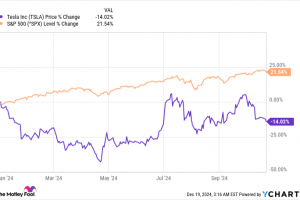
On Wall Street, very few things are guaranteed. However, change is one of the few constants.
Over multiple decades, it’s commonplace for Wall Street’s largest companies by market cap to be shuffled up and down the proverbial leaderboard. New innovations, mounting competition, legal judgments, acquisitions, collaborations, bankruptcies, and even acts of God contribute to this leaderboard carousel.
Image source: Getty Images.
In June, for a brief moment, artificial intelligence (AI) leader Nvidia (NASDAQ: NVDA) ascended to the top pedestal and was the world’s most valuable publicly traded company. But as history has shown time and again, this fairy tale story is unlikely to last.
While high-growth AI stocks are currently enjoying all the glory on Wall Street, it’s my contention that, by 2029, three boring stocks — i.e., time-tested businesses that can continually deliver for investors without being in the spotlight — will be worth more than Nvidia.
History says Nvidia is going to lose its luster
In less than 18 months, we witnessed Nvidia’s valuation soar from $360 billion to a peak of almost $3.5 trillion. This never-before-seen climb for a market-leading business has been driven entirely by excitement surrounding artificial intelligence.
With AI, software and systems are given tasks that humans would typically oversee. The key here is that AI-driven systems have the capacity to learn without human intervention and evolve over time. Nvidia’s graphics processing units (GPUs) are effectively the brains powering decision-making in enterprise AI data centers.
Although Nvidia’s operational ramp has been virtually flawless, history tells investors that its stock is bound to lose its luster, sooner rather than later.
Despite there being a good number of next-big-thing innovations, technologies, and trends over the last three decades, all of which promised big-dollar addressable markets, none managed to avoid an early stage bubble-bursting event. Investors consistently overestimate how quickly businesses and/or consumers will adopt and utilize new technologies or trends. In…
..






